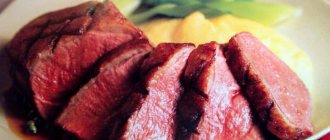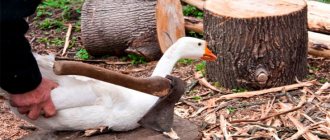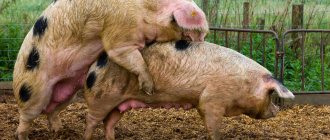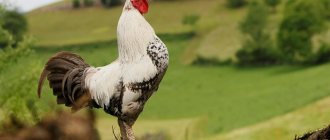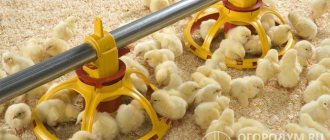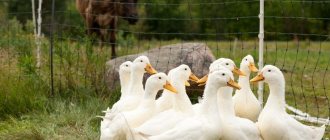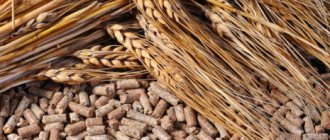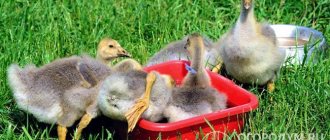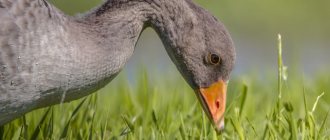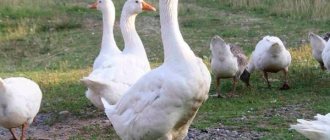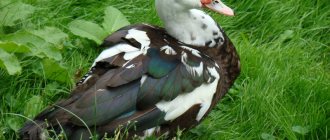Goose meat is always in great demand. Poultry farms, whose main activity is raising geese, are engaged in breeding not only for individual consumption, but also for mass sale. Raising geese for meat is considered to be the most profitable and popular direction in poultry farming. The profitability of the business is due to the unpretentiousness of birds in keeping, as well as the peculiarities of feeding. In addition to dietary meat, you can get feathers and down from geese, as well as such a valuable food product - liver. To prevent the taste of the carcass from deteriorating, it is important to know how to properly slaughter geese for meat and at what age it is best to do this.
How long do geese grow before slaughter?
How long does it take a goose to grow before slaughter? First of all, the timing of geese slaughter depends on the characteristics of the breed being raised, as well as on their diet.
- If birds were fed only natural, nutritious foods from a very early age and they gained weight well, then geese can be slaughtered at the age of 7 months.
- Birds that ate only compound feed will gain about 3-4 kg in 2-3 months. Therefore, they can already be slaughtered at this age.
- Birds raised at home on mixed feeding are ready for slaughter at the age of 5 months.
First, approximately 5 of the most productive individuals are selected from the entire livestock for further breeding. The rest of the young animals can be slaughtered.
If the birds did not have time to gain weight and grow before autumn, then it would be better to leave them for another year. In the winter they are in breeding season, so they lose some weight.
Useful tips for beginners
Beginning farmers should follow these recommendations:
- In spring and summer, feed geese greens. With the arrival of autumn, it is worth introducing more feed into the diet of birds.
- From September, limit the physical activity of birds. This promotes better fat storage. The duration of a daily walk should be 1-1.5 hours.
- Select the best individuals for breeding.
- After slaughter, allow the blood to drain. This affects the quality characteristics of the meat.
In order for the procedure to be successful, before slaughter it is worth familiarizing yourself with the anatomical features of the birds. This will help you slaughter the bird correctly and cut it up . To carry out the manipulation, it is important to use sharply sharpened tools.
Slaughter process
Slaughtering geese at home is not as simple as it might seem at first glance. Therefore, you need to prepare for this process in advance.
Otherwise, one wrong movement when cutting can easily ruin the taste of the meat.
During the slaughter period, geese that will be used for meat must be kept in a separate clean room. They are left there overnight, and the procedure begins in the morning. It is customary to chop down birds so that there are no stumps before the onset of frost. Before slaughter, the wings are folded to one side and the paws are tightly tied. There are several types of slaughter: external and internal. The external method is carried out using a knife as follows:
- The bird is placed head down in a large container;
- Then, before cutting, the carcasses are stunned with a blow to the head;
- A small puncture is carefully made above the ear with a knife and the carotid artery is cut;
- Then the carcass is left so that all the blood drains into the container.
The internal slaughter method is carried out using scissors according to the following algorithm:
- First the goose is hung upside down;
- Then its beak is unclenched and the carotid artery is cut through the oral cavity;
- Next, a puncture is made in the roof of the mouth. The tip of the scissors is placed towards the bird's skull and the brain is pierced.
This procedure makes feather plucking easier. Since the puncture of a specific area of the brain is designed to facilitate the protective function of the body.
You can also cut a goose with an ax:
- The bird's head is cut off with an ax;
- The carcass is then hung upside down to drain the blood;
- You need to wait until all the blood has drained into the container and only then start plucking.
In the process of draining the blood, you need to loosen the ropes in the tied parts of the body so as not to deteriorate the appearance of the carcass.
This will take from 5 to 20 minutes. The main thing is to take your time and wait until the end of the process. Remaining blood in the body can make it unfit for consumption and will also reduce the shelf life of the meat.
All three methods of slaughtering birds are suitable for livestock of any age. You should choose the most convenient one and prepare everything you need for the process in advance. The first two methods take the same time. The third one goes much faster.
How to pluck a bird
After draining the blood from the carcass, you can proceed to the plucking process. To avoid blood getting on the down and feathers, it is recommended to tighten the tip of the neck tightly with a rope. Birds can be plucked dry or wet. The first option is used to collect fluff and feathers. Immediately after plucking, they can be sorted and processed.
See also
What exactly is the difference between swans and geese, description and characteristics of birdsRead
When using the wet method, the carcass must be scalded with boiling water. This option for the procedure is considered simpler and faster.
Goose cutting
Butchering the carcass is a mandatory action. Cutting should be done carefully, as there is a possibility of spoiling the taste of the meat and the appearance of the carcass. The process of cutting poultry consists of several successive stages:
- Before cutting, make sure the carcass is clean. It should be free of fluff, feathers and hairs. You can remove dirt manually or using tweezers;
- After this, the bird's head is cut off. It is best to make the incision in the area of the second vertebra. If head removal was carried out at the time of slaughter, this step is not performed;
- Next, the wings are cut off in the elbow area and the paws in the joint area. These areas are the easiest to cut. The cut parts cannot be used for cooking;
- You can start cutting up the internal organs. First of all, you need to separate the trachea and esophagus from the spine. To remove them, the abdomen is cut. You can also pull out the esophagus and trachea by hand through the cloaca. If this is difficult to do, you can use a knife;
- You need to open the abdomen with a well-sharpened knife, starting from the cloaca and leading down to the keel. The incision is made carefully so that the offal and intestines are not affected;
- Then the offal and other internal organs are removed. It is customary to leave the liver and gizzard for food. The remaining offal can be discarded if desired;
- Next, the cackling tube is removed using a knife;
- After cutting, the entire carcass is washed well and left to “rest” at room temperature for a couple of hours. After this, it can be frozen.
It will not be difficult for an experienced breeder to slaughter and cut up a goose carcass. The most important thing for those who are encountering this process for the first time is to follow the procedure described above. Then the quality of the meat will not suffer, and the bird carcass will have an attractive appearance.
Differences between summer and winter feeding
The diet of goose varies depending on the season. In summer, geese eat green grass; in winter, it needs to be replaced with silage. Feeding geese in the summer is cheaper and easier.
It is enough to feed wet and grain food once a day. In winter, this must be done 3 times. Root vegetables are needed in winter. A winter replacement for green grass is pine or spruce needles ground in a meat grinder.
The period of raising geese should not be very long, because the quality of the meat deteriorates. Usually 4 months are enough for the goose to gain sufficient weight.
Keeping geese requires expense and labor, but brings good results.
Breeding geese at home
The goose is bred and kept on the farm as a slaughter bird to obtain meat, offal, down and feathers. At the same time, according to V. T. Sobichevsky, more than 100 years ago it was recognized that rational goose farming can deliver 75-100% of the capital expended. The goose, like a swimming bird, needs water nearby when breeding - a pond or river; but, being hardy, he easily gets used to his surroundings and is content with a trough or wooden vat of water dug into the ground. It is not afraid even of severe frosts, and therefore the goose coop, or goose house, could be placed in cold stables or sheds. Distinguished by its generally livable behavior (except for fighting geese), this bird is conveniently kept in large flocks.
It is especially important for the successful breeding of geese that they receive sufficient food, constantly have plenty of fresh water and can freely walk near the goose coop. Having a good appetite, the goose eats a lot and soon begins to get fat, which has a detrimental effect on its fertility: the goose stops laying eggs or lays only fatty eggs that do not produce offspring. Previously, it was believed that the best food for geese was oats (garnets, that is, a quarter of a bucket or 3.2798 liters, per day for six heads, in two doses, morning and evening). Diversity of food contributes to obesity and should be especially avoided before egg-laying time, “when the goose is in set.” For obese or salting geese, the portion of food is reduced by half. In a herd, they usually count one gander for every 5-6 geese; the first are suitable for breeding from 2 to 5 years, and the second - from 2 to 8 years, although both of them can live up to 30 years. With proper care, from the beginning of March, and sometimes even from mid-February, egg laying begins, lasting a month and repeating 2-4 times a year. In former times, goslings were not hatched from autumn eggs due to the difficulty of raising them in cold weather.
Contents of goslings
If the chicks are kept without a brood hen, the temperature in the room must be maintained, changing as the goslings grow:
- 1-3 days -28°-30°;
- 3-5 days -25°-28°;
- 6-7 days -23°-25°;
- 8-10 days - no more than 24°;
- 10 – 15 days – 20°-22°;
- 15 -20 day - 18°-20°.
Keeping in a warm room can last up to 30 days depending on the season and weather.
Weak individuals are kept separately and given enhanced nutrition. If the gosling falls, you need to help him get up on his legs; he should not lie on his back for a long time.
The premises are equipped according to the following rules:
- Floor with bedding.
- Lamp with lampshade for uniform heating.
- The feeder and drinking bowl are arranged so that the goslings do not get dirty.
- 24-hour lighting of the poultry house is provided.
After 20 days, the goslings live with the young, no more than two birds per 1 sq.m. Waterfowl geese love water. The presence of a pond improves the quality of life of geese.
Factors influencing life expectancy
The time allotted to each bird is sometimes very different. A whole range of factors influences. For wild geese, this is heredity and living conditions: climate, abundance of food, number of enemies, infections, etc. For farm poultry, the list of factors is no less.
Nutrition
For good health and long life, domestic geese are given the right diet. It helps a lot if there is a pond or meadow nearby where birds swim and graze. This is the key to the health and longevity of their wild relatives.
Store-bought feed is used to a minimum. Sometimes they do without them. Often the food is prepared on the farm. Vegetation is taken as a basis:
- Meadow grasses, nettles, and clover are rich in minerals, vitamins and other substances. The geese are released to pasture or ripped and given greens. Too hard grass is not suitable - there are problems with digestion, even death.
- In the cold season they provide hay and silage .
- Cereals - wheat, oats, barley - crushed or whole, separately or as part of mixtures. Wheat is harvested more often than corn. It has more protein. Plus it costs less.
- Vegetables - beets, potatoes, carrots, pumpkin and others.
- Aquatic vegetation - duckweed and algae. When swimming in a pond, the bird itself obtains this type of food. The owner can make preparations for the winter by collecting and drying the vegetation.
To keep your pets healthy and live longer, their diet includes:
- Salt - at least 2 g per bird.
- Sand, preferably river sand. Small gravel and chalk are suitable. Rocks help digestion. In the body they act as additional “teeth”, that is, they grind food. Farmers control the purity of mineral supplements, as they sometimes contain harmful impurities.
Make sure that the diet contains all the necessary substances: proteins, carbohydrates, fats, fiber, etc. Particular attention is paid to vitamins A, B2, E. Juveniles need them more for proper development. You can choose good store-bought feed and supplements.
Water is especially important. Keep drinking bowls clean. Birds find healthy treats in a pond or other body of water.
Conditions of detention
Geese are unpretentious and adapt to different conditions. However, in order for them to live happily ever after at home, they need the following:
- The room is the right size. 1 m² is allocated per individual.
- Dryness in the poultry house. Dampness in the cold lowers the temperature; in the heat it leads to a “greenhouse effect” in one particular goose barn. Plus, humidity opens the gates to germs and infections.
- Normal ventilation. Pets secrete a lot of fluid. To avoid dampness, air movement is important. In addition, geese need to be protected from drafts.
- Good lighting. With its deficiency, immunity decreases. As a result, the birds get sick and live shorter lives. Daylight hours are about 12 hours. In winter, the lamps are turned on in the morning and evening.
- Suitable temperature. In winter, 0 °C is enough. Adult geese feel good even at -10 °C. However, the geese and their offspring are cold. When the poultry house is well insulated, sometimes it is not heated on purpose. The walls and ceiling are covered with mineral wool. In summer, pets can be left outside. The pen is fenced off and a roof is made to protect it from the sun and wind.
- Dry litter, especially in winter. This is protection from the cold. Pets are “warmly dressed” (fat, feathers), but their paws and beaks are vulnerable. The floor is made of clay or wood. For bedding, use hay, sawdust, and straw.
- Purity. They clean regularly, take care of equipment, and disinfect the poultry house and pen.
- Movement and water. They are allowed out into the yard or pond to warm up and swim. If there is no reservoir, sometimes containers are installed.
- They don't put them in cages like chickens. Geese run freely in a poultry house or pen.
Breed
Heredity and genetics play a serious role. Several breeds of domestic geese have been developed with their own characteristics. They live, on average, a different number of years, for example:
- Javakheti. Such pets are better suited for the southern regions and mountains. They live up to 25–30 years.
- Vladimirskaya is a resistant breed. They live from 24 to 31 years.
- Kholmogorskaya - can be left up to 15–19 years.
- Linda breed - live 17–19 years.
These are average numbers. Some birds can live longer. Although in practice, geese of any breed are slaughtered much earlier.
Goals of poultry farmers
The lifespan is usually determined by farmers. Typically, domestic ones are cut before 3–5 years of age.
When geese are close to sexual maturity, growth slows down. Keeping them is no longer as profitable as before. They eat more and grow less. Body weight is already approximately 75% of the weight of an adult gander. Some are cut for up to a year.
Geese are often slaughtered when they begin to lay fewer eggs. Peak fertility occurs at 2–3 years. Then comes the decline and slaughter. Geese are not kept for more than 8 years. Breeding males are slaughtered before 3–4 years of age.
Representatives of meat breeds are slaughtered when they gain the required weight. The youngest go to slaughter at the age of about 4 months.
Feeding the chicks
Immediately after drying, the chicks are fed. In the first five days, meals are provided every 2 hours.
Best suited:
- Mash hard-boiled eggs with water and crushed wheat.
- Ground oatmeal and peas, soaked in water.
- Bran with herbs are added: nettle, clover.
- Sometimes the mash is made with yogurt or cottage cheese.
- Fish oil and yeast must be present.
- Vitamins and mineral supplements are required.
You should not give sticky mixtures to prevent the nasal passages from becoming clogged. When clogged, inflammation develops.
Record-breaking geese
The age of 20 years is considered respectable for these birds. Few people manage to live longer in nature. Dangers, difficulties, predators take their toll.
On farms, 20 years is also an achievement. It is rare that an owner makes an exception and does not slaughter geese for so long. For example, in Ukraine there was a case when a bird lived for more than 31 years. The hostess left it as the saying goes: for her beautiful eyes of an unusual blue color. The long-living record was recorded in documents. The goose and the owner were awarded a certificate.
There are even more serious achievements among pets. Goose George lived for almost 50 years. He died in 1976, less than 4 months before his anniversary. It is believed that George’s age is also not the limit. Many claim that wild geese live up to 60–80 years.
We solve priority problems
First, we settle the issue with the neighbors. The solution depends on where you live:
- private sector of the city,
- or village.
The goose is a noisy bird. If you live in a city, not every neighbor will like it. Why, as they say, do you need unnecessary troubles and tensions? Better then give up this idea and get another bird.
If you live in a village, then no questions should arise. There is a place there, free grazing. It is much easier to create conditions for maintenance.
Secondly, you don’t need to set large-scale goals in the first year. Especially if you are a novice poultry farmer. The first year is better to try, take a closer look, see if you like this activity. Geese make a lot of dirt. They need to be constantly cleaned up and cleaned up. It may turn out that this is not your thing and it is better to start breeding another bird. For example, chickens also require constant cleaning, but due to the fact that they row, it is much easier to clean up after them.
Thirdly, set up a goose barn. The goose is an unpretentious bird and is not afraid of low temperatures, but it still needs to have a house.
Bird relationships
When separating birds into a tribe, you must always remember about subordination and carefully monitor that there is no cruelty, aggression or persecution in the flock. Very often, a female is allowed into the herd that other individuals do not like for some reason. They will pinch and beat the goose. This will lead to a decrease in its productive qualities (egg production).
Such an individual is necessary:
- separate from the herd;
- try changing to another;
- use it for meat.
There are cases when a pair of birds becomes isolated. Both birds stay away when they are together, but the gander “goes to the left” - it mates with other representatives of the flock. It is advisable to prevent such cases. The couple should be housed separately or separated altogether.
Family relationships (incest among geese)
It often happens that all the geese living in one small village unite into a common flock, and the overly warlike ganders begin to mate with a large number (10-15) of females at once.
When such a flock is maintained for quite a long time, without replacing individuals, long-term sexual relationships arise between family members (mother and son, father and daughter, sister and brother). This should be stopped.
When relatives mate, the viability of the offspring is greatly reduced, degeneration of the genus, low productivity, and deformity of many newly born babies are observed. In such cases, measures must be taken to improve the situation.
To get rid of such relatedness, experts recommend changing males after 3 years. To do this, you should purchase eggs or day-old male babies from a neighboring farm or remote settlement, which is much better.
In the wild, matings of relatives are also sometimes observed, which weaken the body of goslings, but it is very difficult to take them into account due to the constant migration of birds. Under these conditions, the viability of birds quickly increases due to the variety of food, which contains a large amount of natural vitamins.
- plants' seeds;
- green shoots;
- berries;
- other feed.
What can be done about inbreeding
To increase the viability of embryos, experts recommend crossing several breeds at once (usually two). In the wild, this happens “instinctively.” Very often birds of different breeds gather in one body of water and there is always a large selection there.
And people must be content with a limited number of birds and choose from what is available. This is not always good, because almost all farms have the same nutrition and maintenance, which can affect the offspring.
For crossing, it is advisable to use a male of a heavy breed, and a female of an egg-bearing breed (Gorky, Italian, Rhine). Some experts advise mating an ordinary goose and a wild male, but it takes a long time for them to get used to it.
Purchasing young stock
Having decided on the breed, we purchase goslings. When purchasing, you may encounter unscrupulous sellers. They may slip in goslings of the wrong breed or not entirely healthy ones.
It is good to buy birds from a breeder at home. Then there is the opportunity to see the mother herd. See in what conditions it is kept. What kind of geese are they, are they strong, are they large, do you like them. And then, if the seller is not afraid to show all this, then he probably won’t deceive.
It is better to buy not day-old goslings, but those that are five days old. They cost a little more, but their survival rate will be slightly higher. When buying goslings, follow these recommendations.
- Pay attention to the behavior of the goslings. It’s good if they are cheerful and active, squeak loudly, and their necks stretch upward.
- The navel should be overgrown without crusts.
- The tummy is toned.
- Nothing stands out from the nostrils of the beak.
- Check the paws for sprains.
Business registration
You can set up a goose farm:
- As an individual entrepreneur with a simplified tax system of 6% on income and OKVED codes:
- As a legal entity as an LLC with a large-scale business
- As a peasant farm , giving the right to receive government grants and subsidies
OKVED for a goose farm
- 01.24 for breeding poultry
- 52.22 for retail trade
- 51.32 for wholesale trade
You will also need to obtain the following documents:
- permission to erect a building and organize a farm from the local administration
- permission from the Sanitary and Epidemiological Supervision, Veterinary and Fire Services
- agreement for waste and solid waste disposal
- quality certificates for farm products
The farm’s activities are subject to periodic inspections by Rospotreb and Rosselkhoznadzor, the Fire Inspectorate, and the Rostekhsluzhba.
Arrangement of a gooseneck
Geese can be kept in any suitable outbuilding. But you can also build a special goose barn.
Ideally equipped area for geese
What should a gosling be like?
It should be:
- dry,
- with good ventilation, but without drafts,
- clean,
- light,
- spacious.
Measures to fulfill basic requirements
Based on these requirements, the place where the gooseneck will stand should not be flooded during spring floods. It is better to place it on the south side. This way it will be better illuminated and warmed up.
It’s good if the floors are made of boards and raised 20 cm above the ground level. Then soil water will not get inside.
The area of the goose barn must correspond to the number of birds. The norm is 1 goose - 1 square. meter. If this is not observed, the air in the goose barn will be unbearable not only for people, but also for the geese themselves. In such a stinking atmosphere, pathogenic microbes will begin to actively multiply. As a result, various diseases will begin to cling to them.
The floor of the goose barn is covered with bedding. The following materials are used for it:
- shavings,
- sunflower husk,
- sawdust,
- hay,
- chopped ears of corn,
- sphagnum peat.
It insulates the floor, dries the droppings, thereby improving the air in the goose barn. One goose requires about 40 kg of bulk material per year. The litter should not be wet and preferably always clean. To do this, it needs to be changed more often. Do not allow the pen to become dirty. Feathers are an important element of thermoregulation in the body of geese. A clean pen will help you avoid many diseases.
For the winter, it would be good to sprinkle slaked lime on the floor, and lay warm bedding (peat, hay, straw) on top. When litter accumulates, it is updated by gradually adding bedding material. In the spring you will get an excellent fertilizer for the garden.
To enrich goose manure with minerals, mineral fertilizers, such as superphosphate, are sometimes sprinkled onto the litter. It not only improves future manure, but also increases air dryness.
Goose nests
Nests are installed in the poultry house. There should be enough of them. It is calculated so that there are no more than three geese per nest. Do not place them near a cold wall or in direct sunlight. Approximate Dimensions:
- height - 50 - 55 cm,
- length - 60 - 65 cm,
- width - 40 cm,
- sill height - 1 cm.
They use regular litter, just change it more often. It's better to update in the evening. Then in the morning the goose will lay eggs in a clean nest.
Sex determination in birds
Young females and males look almost no different from each other. It's hard to notice the difference. This can be done by experienced goose breeders, but there are often cases when they make mistakes.
The easiest and most recommended way to determine sex is whether the gander has a penis. This copulatory organ is located in the bird's cloaca. There are three known ways to find it. Let's look at each of them.
- The person determining the sex grabs the wings and legs of the bird being examined, turns it over on its back and places it on its knee. For convenience, it is advisable to place some kind of bench or stool under your foot.
- Turning the goose's tail away from you, you need to free your hands - press its left wing with one elbow (right) and its neck with the other. Being in this position, the birds do not resist. The hands of the person examining the specimen are free, and it can be quickly examined.
- The goose is moved so that its tail hangs down a little.
- The tail is bent down.
- Open the cloaca with your fingers (index and thumb).
- The determiner turns the goose onto its back and pinches it in this position between its legs.
- He grabs his stomach with both hands and sticks it up.
- With his fingers he squeezes the cloaca in a circle, pushes it apart and checks.
It differs little from the first one. The difference is that the inspector sits on a chair and places the goose on both knees and inspects it that way.
Some recommendations
When identifying sex, you should carefully and carefully inspect the cloaca. It should be noted that geese have a small appendage there (at the very bottom), but it is very difficult to confuse it with a penis. This is a papilla, it is slightly flattened, and there are no divisions on it.
Inspection of some birds (especially ganders) is very difficult - the cloaca cannot be opened. The goose breaks free, braces itself with its paws, and pinches its leg. Such a bird should be released and examined only after two weeks.
There is no need to act forcefully. It is possible to damage any organs and leave the goose with bruises or injuries that are very difficult to heal.
